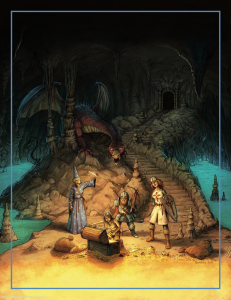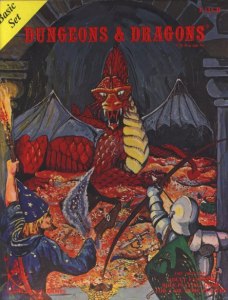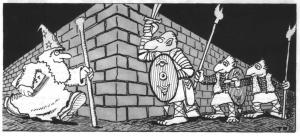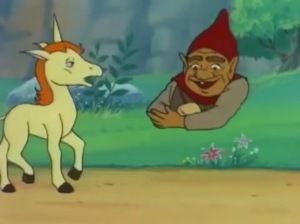“These cyclopean corridors of peril await you and your players as they did my friends and me in 1976 when first we explored the dungeon of John Eric Holmes.”
—Chris Holmes, 2017
History: 1974’s Dungeons & Dragons (White Box) was incoherent, poorly illustrated, and almost unusable by itself. With some Strategic Review & Dragon articles, and then Greyhawk, it slouched towards a playable game.
In 1976-8, Dr. Eric J. Holmes wrote/edited a cleaned-up Dungeons & Dragons Basic Set (Blue Box), and provided a readable, directly usable set of rules, some unique mechanics, new spells, and the art was a great mix of cartoony (Tom Wham), technical (Dave Trampier), and heroic (Dave Sutherland). The sole real defect was that it was limited to Level 3, and had references to ADVANCED DUNGEONS & DRAGONS which turned out to be completely incompatible.
In 1978, I learned to play D&D with Holmes, the just-released Monster Manual (which uses Holmes/White Box/Greyhawk rules, despite saying it’s for AD&D), photocopies of White Box, and Supplement I: Greyhawk. And to this day, that’s what I think of as “Dungeons & Dragons that doesn’t suck”. Holmes has been out of print since the ’80s, and there was a mediocre scan on Paizo’s PDF store for a while (which I have).
Michael Thomas has gone above and beyond with Eric Holmes fandom, used Holmes’ fiction, collaborated with the son Chris Holmes, and brought in these influences, to make a real retro-clone of Holmes’ blue box as it may have been played at his table.
First, the art is excellent. The cover art by Jean-Francois Beaulieu evokes the original Sutherland dragon scene, the interior is black and white, clean line art in most cases. But there’s not much humor to it, it’s very serious business.
| Blueholme |
Holmes |
Beaulieu

|
Sutherland

|
Russ

|
Sutherland

|
Castellani

|
Trampier

|
BKM

|
Wham

|
Rules
These are low-powered, mechanically simple rules. You get bonuses for very few things, the power curve is very flat, and the tables are as weird/buggy as the original. Multi-classing is handled in a way vaguely suggested by how Elves worked in Holmes, adding all XP costs to level up evenly in all multi-classes, and is allowed to all character races. As in Holmes, there are only 5 alignments: Lawful Good, Chaotic Good, Neutral, Lawful Evil, Chaotic Evil. All monsters and unknown things are allowed as races, subject to Dungeon Master Referee approval.
There are places where Blueholme extrapolates rules out differently than other editions, for instance Fighters receive damage bonuses at Level 4+; Magic-Users can create scrolls at low levels (Holmes’ intentional change or misreading of White Box, which only allowed Level 11 Wizards to make scrolls); Thieves immediately receive Read Language, Read Scroll, and Use Wand abilities, instead of waiting for high levels.
Magic-Users in this version are implied to have a library of tomes containing all standard spells, they’re just not all known yet, and can’t be carried along on adventures. I wouldn’t run it like that, because it’s less fun to return to base or have to spend all money on scrolls; just give the M-U a portable spellbook. The spell list is quite complete. Magic Missile is of the White Box/Holmes interpretation that a magic arrow requires an attack roll. Sleep has a range of 240′ (or yards outdoors!) and no save, so hooray, I get to TPK any Level 1-4 party with my Goblin wizards! All the spells are the old interpretations, and balance isn’t really a thing. You’ll be house-ruling things if you want slightly less chaos.
Cleric lists include all the reversed spells with their own names and clearly defined, which may be a first for any D&D game (I just avoid them in Stone Halls & Serpent Men).
“There are generally three distinct types of locale wherein adventure may be found: the Realm, the Wilderness, and the Underworld.”
And these are handled in rather different ways, which is an interesting way of encouraging Basic-style gameplay: Downtime in the mostly peaceful Realm, quick, dangerous runs through Wilderness, and long delves into the Underworld.
Combat uses Holmes’ initiative system, counting down Dex from highest to lowest in each of 5 combat phases. It plays out very differently than other D&D editions and OSR games, you really need waves of spell-casters, archers, and melee fighters. There’s not exactly unique weapon damage like Greyhawk, but a rule to distinguish small and large weapons.
The combat tables are generally just like White Box, with AC 9 (unarmored) down to AC 2 (plate & shield), and improvements in large steps every 3, 4, or 5 Levels. Saving throws are Breath Weapon, Wand/Touch, Gaze, Ray/Poison, Spell/Staff, similar to Holmes but differently ordered (since traditionally, but not specified in these rules, you choose the left-most applicable save, this can be a little different).
One place where this is anachronistic is that Thieves in Greyhawk fought and saved as Magic-Users; Holmes’ tables didn’t go all the way up, but implied they saved as Fighters; in Blueholme Thieves fight and save as Clerics. This is a slight power creep, and while it helps single-class Thieves, I’m leery of Magic-User/Thieves getting a cheap upgrade.
The Monsters are mostly the Holmes list, which had a lot of lower-level creatures with a few higher-level (implausibly so for Level 3 chars!) threats. There’s a fair amount of Greyhawk, Blackmoor, and Eldritch Wizardry monsters, often renamed a bit. And new monsters, such as Angel, Carnosaur, Cyclopian, Dagonite, Deep One, Demon (Normal, Large, or Huge, with a random roll table for powers rather than “Types”), Dreenoi (a SF insectoid race), Golem, Great Race, Green Grabber, Mayhar, Mi-Go, Old One, “Sagroth” aka White Apes, Sauropod, and Thipdon. Holmes’ fiction implied an H.P. Lovecraft/Clark Ashton Smith cosmology, and the game actually supports that. However, there’s no stats or mechanics for the greater entities of the Mythos, or insanity, which is disappointing.
There’s no experience for monsters table. And good luck finding even the experience rules, they’re under Adventures instead of next to Characters. You might search for the Greyhawk experience table, or look at Delta’s XP: The Big Switch posts, or even just go back to White Box’s rule of 100 XP per HD, which makes low levels go very fast but is later the same as Greyhawk’s table.
The encounter tables often refer to monsters by their stock D&D names, not the Blueholme names, so you’ll be converting and page-flipping if you want to use them.
There’s an entirely new treasure table, which has slightly less coinage at first glance, but greatly increased numbers and values of gems & jewelry (far more likely to be 1000 GP or more). Armour, weapon, and misc magic item tables are longer, giving high-level loot, but there are no intelligent weapons, which were a mainstay of White Box, or artifacts as in Eldritch Wizardry. I don’t hate these tables, but they’re not suitable for stocking a dungeon without careful picking and choosing.
- Vampire in Holmes: 10%: 2-20 x 1000 SP, 20%: 1-8 x 1000 EP, 45%: 1-12 x 1000 GP, 30%: 1-6 x 1000 PP, 20%: 2-24 Gems, 10%: 1-12 Jewelry, 30%: 3 non-weapon magic + 1 potion + 1 scroll
- Vampire in Blueholme: 50%: 1d4 Gems/Jewelry, plus 10%: 3d6 x 500 SP, 20%: 2d8 x 500 EP, 45%: 4d6 x 500 GP, 30%: 2d6 x 500 PP, 15%: 6d6 Gems/Jewelry, 30%: 1 any item + 1 potion + 1d6 scrolls.
Campaigns explains how to design and stock maps, and some of the advice seems usable, but there is no equivalent to Holmes’ Great Stone Skull Mountain or sample dungeon (certainly the first good dungeon design I ever read), and the only examples of play in Blueholme are combat; Holmes spent pages on narration of exploration & mapping.
At the end is an optional rule for making ability rolls, 3d6 vs. ability score, with a short example. This is perhaps the only real nod to modernity, the kind of thing we did ad hoc back in the day but never had a consistent rule about.
Rating
- Presentation: ★★★★☆ A lovely book, painstakingly correctly laid out. There are few errors I’ve found.
- Organization: ★★★☆☆ Straightforward D&D organization, except perhaps that the optional character rules should not be on the last page. But there’s no index, and that’s a problem. With the PDF at least I can search for keywords, but in print this is hard to use.
- Rules: ★★★★☆ For a traditional D&D-type game, this is the one you should play. If you can find an XP table.
- Setting: ★★☆☆☆ Aside from the monsters, there’s just no setting, no adventure, no anything to suggest this isn’t in a white void combat arena. Holmes’ few pages of backstory, town, and sample dungeon at least gave it context. Super disappointing.
- Utility: ★★★★☆ Sit down and run an old adventure. You don’t need to house rule much (at least at first), and it’s immediately playable.
- Average: ★★★½☆ I love this book, but the flaws are also significant. I still think it’s the best straight-up retroclone; not a “new game sort of like D&D”, but “what D&D was like when I liked it”.










You must be logged in to post a comment.